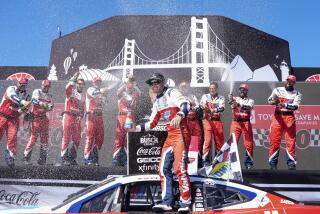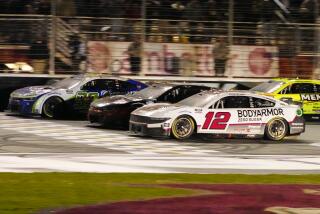Decision to go ahead with auto race is all wet
FONTANA -- The jet dryers spent more time on the track of the newly renamed Auto Club Speedway than the cars they preceded in Sunday’s Auto Club 500 race.
Time and again, the turbine-powered machines were sent out to circle the two-mile oval in an effort to dry the water that had been deposited during several days of intermittent rain.
At one point Sunday afternoon the sun emerged from behind a bank of clouds to inspire hope that its rays -- and the heat generated by the 43 cars entered in the second race of the Sprint Cup series -- would combine with the dryers to make the track safe for the 250-lap race.
The drivers wanted to drive. The fans, many of whom drove here in a downpour and crossed muddy parking lots to get to the grandstand, wanted to watch them drive.
After a delay of more than two hours the race was on.
And after 22 laps and two water-related accidents, it was off.
In the day’s first mishap, Denny Hamlin’s Toyota Camry slid and hit the wall in Turn 3 of Lap 14. In the second, four cars tangled in Lap 21, a crash that left Casey Mears’ Chevrolet on its side and Sam Hornish Jr.’s Dodge on fire.
No one was hurt, but the race was halted for 67 minutes.
By the time they completed 87 laps and had to stop again at 6:11 p.m. -- this time for more than four hours -- race officials had issued seven cautions because of bad weather or debris on the track.
The race was scheduled to resume at 11 p.m., and only a handful of fans remained in the stands huddled under ponchos or makeshift shelters crafted out of plastic sheets. NASCAR officials finally decided just before 11 p.m. to postpone the race until this morning.
Those officials should be grateful that the day’s casualty list was limited to dented sheet metal, sheared off bolts and shredded rubber.
That list could easily have included broken bones and battered bodies.
Many drivers said the track was not ready when the race began, and that’s alarming.
Even allowing for some drivers who may have latched onto the slick spots on the track as an excuse to cover their own mistakes and misfortunes, it’s clear that conditions were borderline at best.
At worst, those conditions may have endangered the drivers, and that’s inexcusable.
Several extra pace laps were run to generate air flow and promote drying, and the track appeared to be tolerable.
“I thought after we started racing it might help as the track temperature went up, with the heat from the cars. But it started getting a little bit worse at both ends of the tracks,” said Jeff Gordon, who was sixth after 87 laps.
Not long after the race began, water started seeping up through the seams where sections of asphalt were joined, producing small puddles that drivers call weepers. Hamlin blamed the water on the track for his crash.
“I hit a slick spot and my car took off,” he said. “You can see it on television -- right at the seams it’s seeping a lot of water. I hit a wet spot and I’m not going to be the last one.”
Mears also slid on a wet spot and clipped the car of his Hendrick Motorsports teammate, Dale Earnhardt Jr. Hornish couldn’t avoid their bang-up, crashing into Reed Sorenson’s Dodge and then Mears’ Impala.
“As we crossed the bottom seam, getting in and out of [turns] one and three and four, if you weren’t quite low enough it was wet,” Mears said. “The track is still seeping a good bit of water.”
There was nothing good about this seepage.
Jimmie Johnson, the leader at the 87th-lap delay, said the problem had first occurred Friday during qualifying. Drivers who changed lanes over the wet seams “really upset the car,” he said. “So you just kind of picked your lane early and just followed that around as though you were on the Interstate almost between the dotted lines and rolled the turn.”
Dario Franchitti, a Scotsman who is accustomed to cold weather, didn’t much care for the rain-slicked track or the evening chill.
“The seams on the track are like ice out there,” he said. “As soon as you hit a seam you lose like three or four places.”
He offered his sympathy for the fans who sat through all the delays. As he spoke to a TV interviewer, he shivered.
“It’s bloody freezing,” he said. “It’s California and I’m freezing. We’ve been fighting this weather all week, and now I’m going to go find myself someplace warm to hang out.”
Not a Chamber of Commerce moment.
A Nationwide Series race that was originally scheduled for Saturday and had been postponed until Sunday because of the weather was postponed again, until today. The Auto Club 500 should have been postponed earlier, too.
NASCAR did its fans and TV audience no favors by dragging out Sunday’s race in an effort to get a result.
It did its drivers a disservice by subjecting them to a long, tedious day and perilous conditions on the track -- not to mention the perils of driving the soggy freeways afterward.
--
Helene Elliott can be reached at helene.elliott@latimes.com. To read previous columns by Elliott, go to latimes.com/elliott.
More to Read
Go beyond the scoreboard
Get the latest on L.A.'s teams in the daily Sports Report newsletter.
You may occasionally receive promotional content from the Los Angeles Times.











